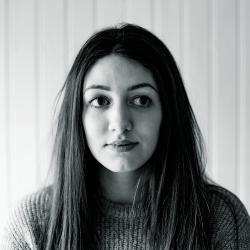As much as I love going on tours, I initially wasn’t filled with excitement about my recent day trip to Reykjanes. In retrospect, it was stupid of me to think that it wouldn’t be impressive, just because it hasn’t been discovered by as many tourists as the Golden Circle. But let me tell you—it will be. And I hope you get there before the crowds do.
Sleepy and in need of some caffeine, we’re picked up early by our guide, Bjarni, who doesn’t mind stopping for coffee along the way. Maybe he noticed that I can’t really function without it. Bjarni seems like the type of friend you meet during an exchange program, eager to show you around their country—both fun to be around, and very fond of his homeland.
On the drive, Bjarni tells me about how he and three friends started their tourism business two years ago, because of a love for the area. “I think people are really getting what they’re coming to Iceland for at the Reykjanes Peninsula,” he says. “You can kind of just feel the environment, and its quietness.”





The green lake
Our first stop is Krýsuvík, which has unusually coloured scenery peeking out from the snow cover. Spots of copper red and bubbly blue-green puddles surround us as we walk up the path. The steam carries a hint of sulphur. Bjarni walks around with us, without any time pressure. A bit further up, there’s a still green lake, in contrast to the bubbling hot spring area.



Rough and wavy
As you may know, Iceland has many seaside cliffs and mountains. My favourite was Arnarstapi on the Snæfelsness Peninsula—until I got out of the car at our next stop, Krýsuvíkubjarg. We walk a rocky path to get as close as possible to the rough waves clashing against the rocks. We watch the sun come up in the distance and our guide tells us there’s a hidden pool, secluded from the rough sea, where he goes swimming in summer.



Soup with locals
By the time we get to Bryggjan, a small diner by the harbour village of Grindavík, we’re just hungry enough to warm up with some hot meat soup. The place is filled with decorations, each with its own story—tales that the owners gladly relate. This rustic little place is much appreciated by locals, who sit around talking about the good old days while a Chinese family enjoy their meal in the other corner. Having finished our lunch, we get back in the car and head for the next sight of the day.




Haunted fog
Arriving at Gunnuhver, I immediately get a sense of mystery because of the thick geothermal fog around the area. Our guide tells us the story of a ghost, Gunna, who haunted the area for years after she died in 1703. This hot spring area, in those times, was thought to have a close resemblance to hell. A known sorcerer at that time lured the ghost into the steam to stop the haunting—to this day, the area is named after Gunna.

Antique lighthouse
Next we drive past a lighthouse on a hill—Reykjanesviti, the oldest lighthouse in Iceland. It was built 1873, but collapsed, and was only restored eight years later. It’s unusually located adjacent to the shoreline, but because it’s 77 metres above sea level, it was considered a perfect site anyway. Bjarni notes that the lighthouse keeper is also a cab driver.



The toe
The next stop we get out of the car is called Reykjanestoe—and no, I didn’t make that up. We walk up the hill to view the cliff and the small island of Eldey in the distance. Eldey is also known as “the bird island”. Apparently, they fill up the landscape during summer. Besides the far off island, steep rocks break the waves closer to shore.



Explosion craters
We hop out of the car at one of the many craters, Stampar. It erupted in the year 1210, for about 30 years. It’s one of a long line of craters that expanded the peninsula’s landmass with lava, and made it into the volcanic area it is today. Bjarni explains how he never sees anyone stop here, while it’s actually his favourite stop of the tour. When I get up to the crater, I find out why. It’s full of coloured red and blue stones, and from the top you can clearly see the line of craters that have been here for hundreds of years.



A tale of two continents
Our last stop is a bridge that spans the gap between the Eurasian and American tectonic plates. It’s the only place during our whole trip where we see a tour bus. Bjarni explains how the two plates move gradually further away from each other each year. This process is how Iceland’s land mass formed in the first place, and also why earthquakes here aren’t as destructive as in other places.
Before heading home, Bjarni offers us a taste of Icelandic hardfiskur at his fish store on the way back to Reykjavík. Of course, we don’t turn that offer down. I leave this trip having discovered all about this calm and secluded part of Iceland, mostly thanks to our guide’s true enthusiasm for the beautiful Reykjanes Peninsula.

Reykjanes Tours offers two all-year-round tours in the area: the Reykjanes Express, a short tour for people on a layover, or on their way to the airport (3 hours); and the full Reykjanes Peninsula tour (5 hours).
Buy subscriptions, t-shirts and more from our shop right here!










